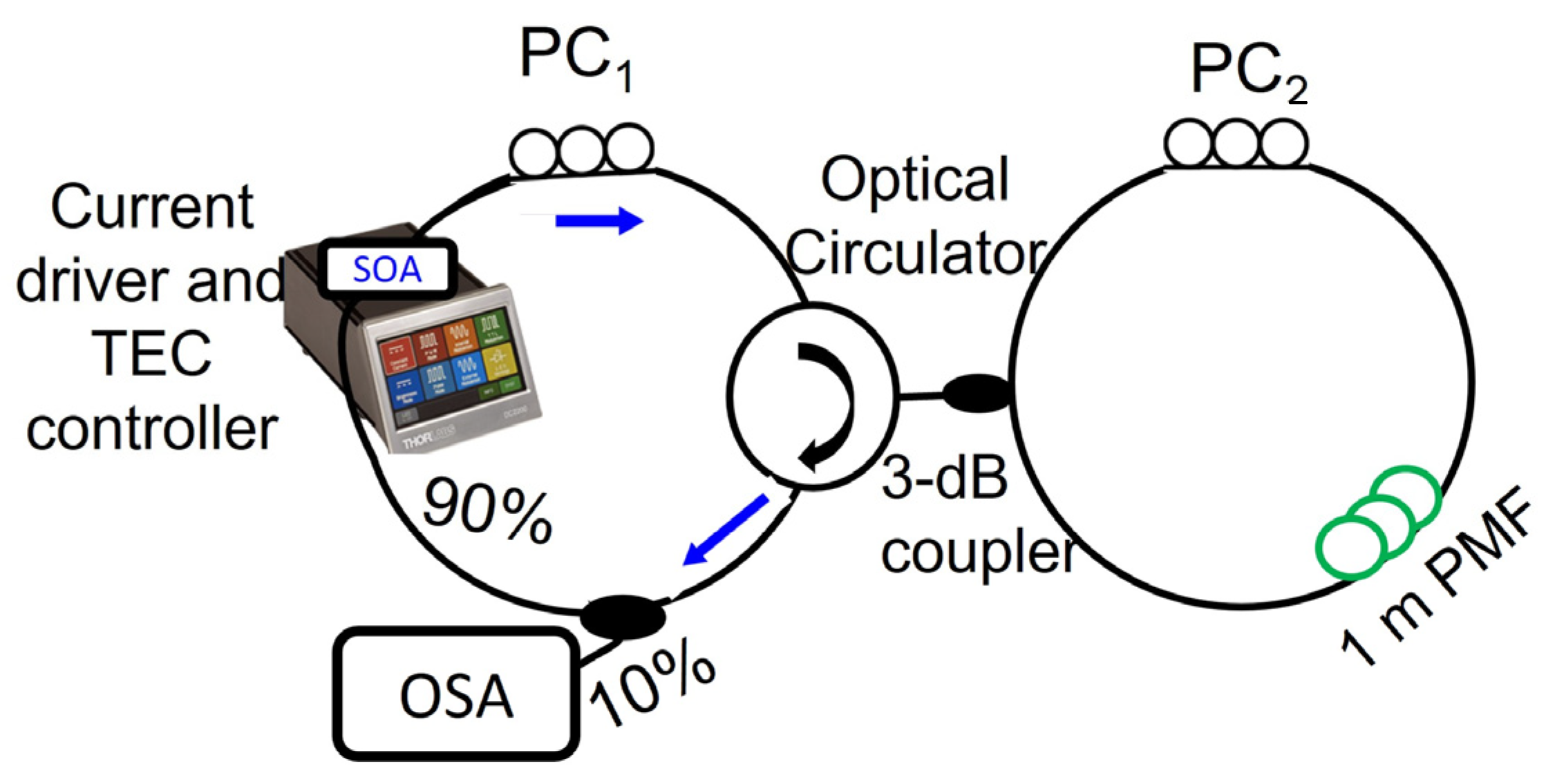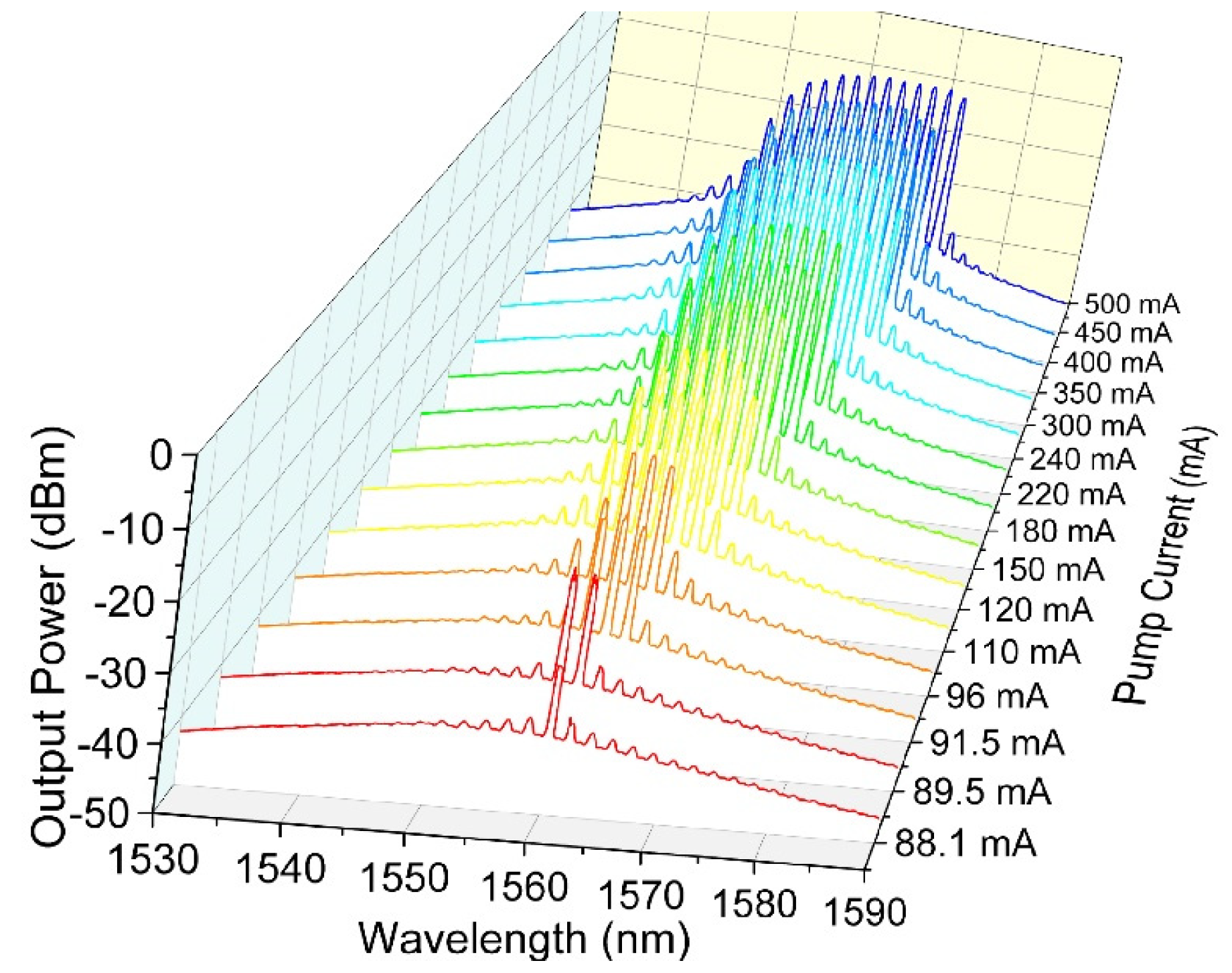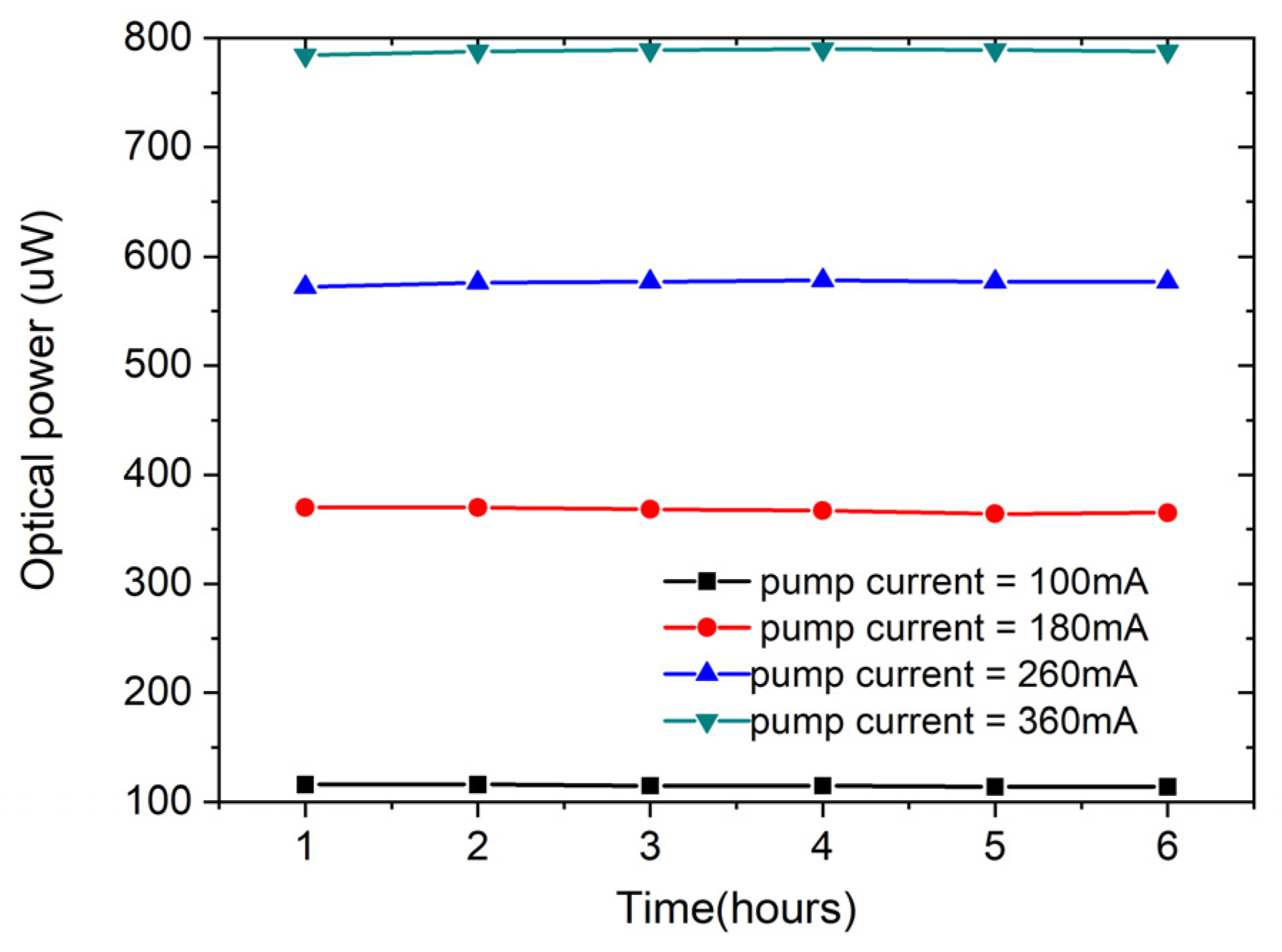Tunable Multiwavelength SOA-Based Fiber Laser
Abstract
1. Introduction
2. Experimental Setup
3. Results and Discussion
4. Conclusions
Author Contributions
Funding
Data Availability Statement
Acknowledgments
Conflicts of Interest
References
- Zhao, Z.; Li, X.; Li, Y.; Qin, H.; Wang, H.; Luo, Y.; Yan, Z.; Sun, Q.; Liu, D.; Zhang, L. Multiwavelength Er-doped fiber laser using an all-fiber Lyot filter. Appl. Opt. 2018, 57, 9270–9274. [Google Scholar] [CrossRef]
- Moon, D.S.; Paek, U.-C.; Chung, Y. Multi-wavelength lasing oscillations in an erbium-doped fiber laser using few-mode fiber Bragg grating. Opt. Express 2004, 12, 6147–6152. [Google Scholar] [CrossRef] [PubMed]
- Zhao, Q.; Pei, L.; Zheng, J.; Tang, M.; Xie, Y.; Li, J.; Ning, T. Switchable Multi-Wavelength Erbium-Doped Fiber Laser with Adjustable Wavelength Interval. J. Light. Technol. 2019, 37, 3784–3790. [Google Scholar] [CrossRef]
- He, W.; Zhang, W.; Zhu, L.; Lou, X.; Dong, M. C-band switchable multi-wavelength erbium-doped fiber laser based on Mach–Zehnder interferometer employing seven-core fiber. Opt. Fiber Technol. 2018, 46, 30–35. [Google Scholar] [CrossRef]
- Tang, M.; Jiang, Y.; Li, H.; Zhao, Q.; Cao, M.; Mi, Y.; Wu, L.; Jian, W.; Ren, W.; Ren, G. Multi-wavelength erbium-doped fiber laser with tunable orbital angular momentum mode output. J. Opt. Soc. Am. B 2020, 37, 834. [Google Scholar] [CrossRef]
- Kim, N.S.; Zou, X.; Lewis, K. CW depolarized multiwavelength Raman fiber ring laser with over 58 channels and 50 GHz channel spacing. In Proceedings of the Optical Fiber Communication Conference, Anaheim, CA, USA, 17 March 2002. [Google Scholar] [CrossRef]
- El-Taher, A.E.; Harper, P.; Babin, S.A.; Churkin, D.V.; Podivilov, E.V.; Ania-Castanon, J.D.; Turitsyn, S.K. Effect of Rayleigh-scattering distributed feedback on multiwavelength Raman fibre laser generation. Opt. Lett. 2011, 36, 130–132. [Google Scholar] [CrossRef]
- Chen, D.; Qin, S.; He, S. Channel-spacing-tunable multi-wavelength fiber ring laser with hybrid Raman and Erbium-doped fiber gains. Opt. Express 2007, 15, 930–935. [Google Scholar] [CrossRef]
- Qureshi, K.; Tam, H.Y.; Chung, W.H.; Wai, P.K.A. Multiwavelength Laser Source Using Linear Optical Amplifier. IEEE Phot. Tech. Lett. 2005, 17, 1611–1613. [Google Scholar] [CrossRef]
- Kbashi, H.J.; Sharma, V.; Sergeyev, S. Phase-stable millimeter-wave generation using switchable dual-wavelength fiber laser. Opt. Lasers Eng. 2021, 137, 106390. [Google Scholar] [CrossRef]
- Kbashi, H.J.; Sharma, V.; Sergeyev, S. Dual-wavelength fiber-laser-based transmission of millimeter waves for 5G-supported Radio-over-Fiber (RoF) links. Opt. Fiber Technol. 2021, 65, 102588. [Google Scholar] [CrossRef]
- Sharma, V.; Kbashi, H.J.; Sergeyev, S. MIMO-employed coherent photonic-radar (MIMO-Co-PHRAD) for detection and ranging. Wirel. Netw. 2021, 27, 2549–2558. [Google Scholar] [CrossRef]
- Kbashi, H.J.; Vishal, S.; Sergeyev, S. Transmission of 5G using Tunable Dual-Wavelength Fiber Laser. In Proceedings of the 2021 Conference on Lasers and Electro-Optics Europe & European Quantum Electronics Conference (CLEO/Europe), Munich, Germany, 21–25 June 2021; p. 1. [Google Scholar] [CrossRef]
- Moon, D.-S.; Chung, Y. Multi-wavelength fibre ring laser based on a sampled chirped fibre Bragg grating with a hybrid gain medium. Opt. Commun. 2012, 285, 1908–1910. [Google Scholar] [CrossRef]
- Yin, G.; Lou, S.; Wang, X.; Han, B. Tunable multi-wavelength erbium-doped fiber laser by cascading a standard Mach–Zehnder interferometer and a twin-core fiber-based filter. Laser Phys. Lett. 2013, 10, 125110. [Google Scholar] [CrossRef]
- Zhou, K.; Zhou, D.; Dong, F.; Ngo, N.Q. Room-temperature multiwavelength erbium-doped fiber ring laser employing sinusoidal phase-modulation feedback. Opt. Lett. 2003, 28, 893–895. [Google Scholar] [CrossRef] [PubMed]
- Quan, M.; Li, Y.; Tian, J.; Yao, Y. Multifunctional tunable multiwavelength erbium-doped fiber laser based on tunable comb filter and intensity-dependent loss modulation. Opt. Commun. 2015, 340, 63–68. [Google Scholar] [CrossRef]
- Sulaiman, A.; Zamzuri, A.; Hitam, S.; Abas, A.; Mahdi, M. Flatness investigation of multiwavelength SOA fiber laser based on intensity-dependent transmission mechanism. Opt. Commun. 2013, 291, 264–268. [Google Scholar] [CrossRef]
- Yao, J.; Yao, J.; Deng, Z.; Liu, J. Multiwavelength erbium-doped fiber ring laser incorporating an SOA-based phase Modulator. IEEE Photon-Technol. Lett. 2005, 17, 756–758. [Google Scholar] [CrossRef]
- Chen, D.; Ou, H.; Fu, H.; Qin, S.; Gao, S. Wavelength-spacing tunable multi-wavelength erbium-doped fiber laser incorporating a semiconductor optical amplifier. Laser Phys. Lett. 2007, 4, 287–290. [Google Scholar] [CrossRef]
- Zhang, Z.; Wu, J.; Xu, K.; Hong, X.; Lin, J. Tunable multiwavelength SOA fiber laser with ultra-narrow wavelength spacing based on nonlinear polarization rotation. Opt. Express 2009, 17, 17200–17205. [Google Scholar] [CrossRef]
- Im, J.E.; Kim, B.K.; Chung, Y. Stable SOA-based multi-wavelength fiber ring laser using Sagnac loop mirror incorporating a high-birefringence photonic crystal fiber. Laser Phys. 2010, 20, 1918–1922. [Google Scholar] [CrossRef]
- Yan, N.; Silvira, T.; Teixeira, A.; Ferreira, A.; Tangdingga, E.; Monteriro, P.; Koonen, M.J. 40 Gb/s All-Optical Mul-ti-Wavelength Conversion via a Single SOA-MZI for WDM wavelength Multicast. In Proceedings of the 12th Optoelectronics and Communication Conference on Integrated Optics and Optical Fibre Communication (OECC/IOOC 2007), Pacifico Yokohama, 9–13 July 2007. [Google Scholar] [CrossRef]
- Sulaiman, A.H.; Yusoff, N.; Abdullah, F.; Mahdi, M.A. Tunable multiwavelength fiber laser based on bidirectional SOA in conjunction with Sagnac loop mirror interferometer. Results Phys. 2020, 18, 103301. [Google Scholar] [CrossRef]
- Lo, H.-K.; Curty, M.; Tamaki, K. Secure quantum key distribution. Nat. Photon. 2014, 8, 595–604. [Google Scholar] [CrossRef]
- Yin, H.-L.; Fu, Y.; Li, C.-L.; Weng, C.-X.; Li, B.-H.; Gu, J.; Lu, Y.-S.; Huang, S.; Chen, Z.-B. Experimental quantum secure network with digital signatures and encryption. Natl. Sci. Rev. 2023, 10, nwac228. [Google Scholar] [CrossRef] [PubMed]
- Riggs, B.; Partridge, M.; Cambou, B.; Burke, I.; Rios, M.A.; Heynssens, J.; Ghanaimiandoab, D. Multi-Wavelength Quantum Key Distribution Emulation with Physical Unclonable Function. Cryptography 2022, 6, 36. [Google Scholar] [CrossRef]







Disclaimer/Publisher’s Note: The statements, opinions and data contained in all publications are solely those of the individual author(s) and contributor(s) and not of MDPI and/or the editor(s). MDPI and/or the editor(s) disclaim responsibility for any injury to people or property resulting from any ideas, methods, instructions or products referred to in the content. |
© 2023 by the authors. Licensee MDPI, Basel, Switzerland. This article is an open access article distributed under the terms and conditions of the Creative Commons Attribution (CC BY) license (https://creativecommons.org/licenses/by/4.0/).
Share and Cite
Kbashi, H.J.; Sharma, V.; Sergeyev, S.V. Tunable Multiwavelength SOA-Based Fiber Laser. Electronics 2023, 12, 3277. https://doi.org/10.3390/electronics12153277
Kbashi HJ, Sharma V, Sergeyev SV. Tunable Multiwavelength SOA-Based Fiber Laser. Electronics. 2023; 12(15):3277. https://doi.org/10.3390/electronics12153277
Chicago/Turabian StyleKbashi, Hani J., Vishal Sharma, and Sergey V. Sergeyev. 2023. "Tunable Multiwavelength SOA-Based Fiber Laser" Electronics 12, no. 15: 3277. https://doi.org/10.3390/electronics12153277
APA StyleKbashi, H. J., Sharma, V., & Sergeyev, S. V. (2023). Tunable Multiwavelength SOA-Based Fiber Laser. Electronics, 12(15), 3277. https://doi.org/10.3390/electronics12153277





